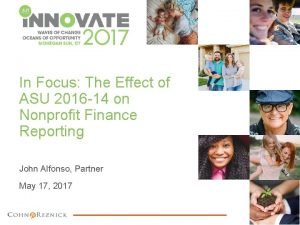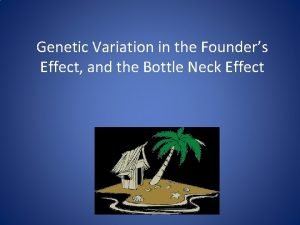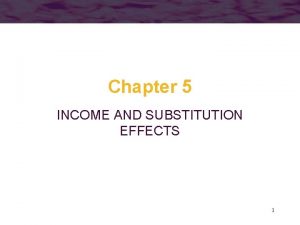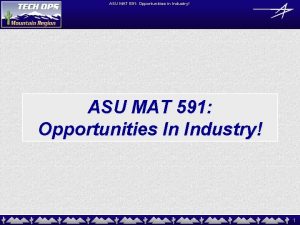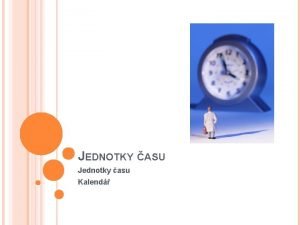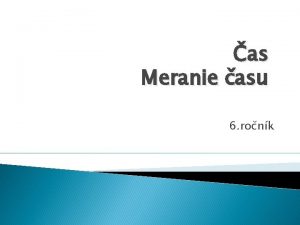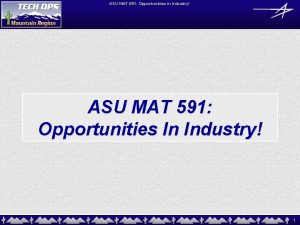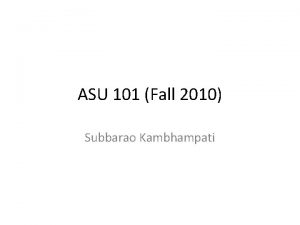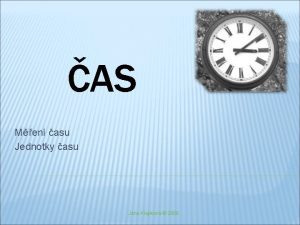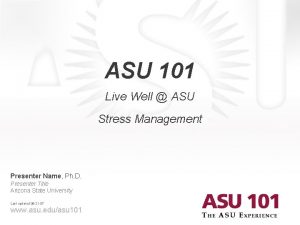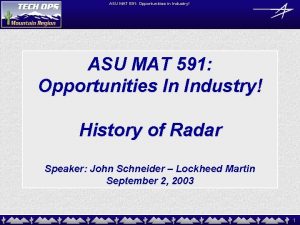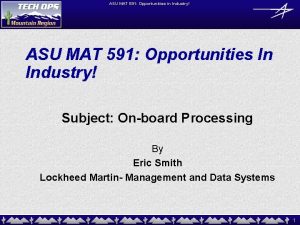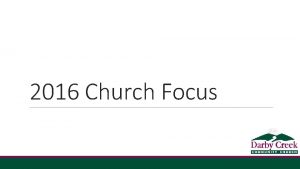In Focus The Effect of ASU 2016 14







































- Slides: 39

In Focus: The Effect of ASU 2016 -14 on Nonprofit Finance Reporting John Alfonso, Partner May 17, 2017

Reminders Ringer Silent

Objectives and Background

OBJECTIVES OF TODAY’S PRESENTATION After today’s conversation, you should be familiar with: • • • Background leading up to the new ASU Significant changes to current practice Qualitative and quantitative requirements Impact to stakeholders What organizations can do to prepare for the changes Effective date and transition guidance

BACKGROUND • On August 18, 2016, the FASB issued ASU 2016 -14, Presentation of Financial Statements of Not-for-Profit Entities • This new guidance will be the first major set of changes to not-for-profit financial statement reporting standards since the issuance of FASB 117 in 1993, which established the current guidance • While the FASB believes that the existing standards are still sound, stakeholders felt the standards could be improved to provide better information to donors, grantors, creditors, and other users of financial statements.

BACKGROUND • The FASB’s Not for Profit Advisory Committee (NAC) was established in 2009. • Its mission is to ensure that the not-for-profit sector’s concerns are communicated to the FASB. • The NAC consists of 18 members in the not-for-profit sector and includes preparers, auditors and users of financial statements • In 2011, the FASB added the not-for-profit Financial Reporting project to its agenda as a result of recommendations from the NAC

BACKGROUND • In April 2015, the FASB issued the Exposure Draft for public comment • The FASB received approximately 260 comment letters from preparers, users, auditors, academics and others. • The FASB also held public roundtables, workshops and other outreach meetings. Based on the feedback, the FASB decided to split the project into 2 phases. – Phase 1 – Were changes that had broad support, did not depend on other projects and were improvements that the FASB could make quickly. Phase 1 culminated in this ASU. – Phase 2 – The FASB deferred its more controversial proposals which included requiring the same defined measure of operations for all not-for-profit’s to Phase 2. The FASB has not said when it will complete Phase 2.

REDELIBERATIONS PLAN ASU 2016 -14 issued August 2016 Phase 2: Need to decide whether to wait to deliberate at same time as the Financial Performance Reporting project for business entities * Source: FASB Presentation, IN * Source: FASB Presentation, FOCUS: Accounting Standards Update on Not-for-Profit Financial Statements (ASU 2016 -14) - Sept 2016

Significant Changes

WHAT ARE THE KEY PROVISIONS OF THE NEW STANDARD? • Revises the net asset classification to two classes instead of the previous three. – With donor restrictions – Without donor restrictions • Enhances disclosures for self-imposed limits on the use of resources without donor-imposed restrictions (designated net assets) and the composition of net assets with donor restrictions. • Updates the accounting and disclosure requirements for underwater endowment funds. • Requires net presentation of investment expenses against investment return and eliminates the requirement to disclose investment expenses

WHAT ARE THE KEY PROVISIONS OF THE NEW STANDARD? • Requires the presentation of expenses by nature as well as function • Requires qualitative disclosures on how a not-for-profit manages its available liquid resources. • Requires quantitative disclosures that communicate the availability of financial assets to meet cash needs for general expenditures within one year of the balance sheet date. • Allows for a choice between the direct and indirect method of reporting operating cash flows. What does Cohn. Reznick Think? We think it is important to begin educating your stakeholders (e. g. , bankers, donors, board members, etc. ) about these changes. We strongly encourage you to engage your board members and key management personnel in your implementation process.

NET ASSETS Current GAAP Revised GAAP + Disclosures Unrestricted Temp. Restricted Perm. Restricted Without Donor Restrictions* With Donor Restrictions* Amount, purpose, and type of board designations ** Nature and amount of donor restrictions * Not-for-Profits may choose to disaggregate further ** New disclosure requirement * Source: FASB Presentation, IN * Source: FASB Presentation, FOCUS: Accounting Standards Update on Not-for-Profit Financial Statements (ASU 2016 -14) - Sept 2016

WHY THE CHANGE IN NET ASSET CLASSIFICATION? • To reduce complexity • The distinction between permanent and temporary restrictions has been blurred due to changes in state laws and the widespread adoption of the Uniform Prudent Management of Institutional Funds Act of 2006 (“UPMIFA”). • Important things to keep in mind: – Donor stipulations will be the only factor in determining how net assets are classified. – Although net assets may have no donor restrictions, there may still be other restrictions that must be disclosed (e. g. board designated) What does Cohn. Reznick Think? Although there will be a reduction in the net asset classifications on your balance sheet, you should be careful to not lose track about restrictions in your general ledger.

EXAMPLE OF A STATEMENT OF FINANCIAL POSITION Showing Revised Net Asset Classes * Reproduced from FASB ASU 2016 -14 (958 -205 -55 -9)

ALTERNATIVE EXAMPLE OF PRESENTATION OF NET ASSET SECTION of Statement of Financial Position * Reproduced from FASB ASU 2016 -14 (958 -210 -55 -3)

NET ASSET DISCLOSURES • Must still disclose information about the nature and amounts of donor imposed restrictions. • Not-for-profit’s will be able to report separate line items within net assets with donor restrictions on the statement of financial position or in the notes to the financial statements, to distinguish between the types of donor-imposed restrictions. • The new standard requires disclosure of the amounts and purposes for ALL board-designated net assets ( for example, those designated for future expenditures, capital projects or other uses). What does Cohn. Reznick Think? The FASB has said that these are the minimum requirements. The FASB does not preclude not-forprofits from disclosing more information in an effort to tell their story.

SAMPLE FOOTNOTE: NET ASSETS WITH DONOR RESTRICTIONS Example Footnote “B” * Reproduced from FASB ASU 2016 -14 (958 -205 -55 -21)

EXAMPLE FOOTNOTE FOR BOARD DESIGNATED NET ASSETS Note DD Not-for-Profit Entity A’s governing board has designated, from net assets without donor restrictions of $92, 600, net assets for the following purposes as of June 30, 20 X 1. Quasi-endowment $ 36, 600 Liquidity reserve $ 1, 300 Total $ 37, 900 * Reproduced from FASB ASU 2016 -14 (958 -205 -55 -21)

“UNDERWATER” ENDOWMENTS Revised net asset classification • To be reflected in net assets with donor restrictions rather than in net assets without donor restrictions Enhanced disclosures • In addition to aggregate amounts by which funds are underwater (current GAAP), also disclose aggregate of original gift amounts (or level required by donor or law) for such funds, fair value, and any governing board policy, or actions taken, concerning appropriation from such funds. * Source: FASB Presentation, IN * Source: FASB Presentation, FOCUS: Accounting Standards Update on Not-for-Profit Financial Statements (ASU 2016 -14) - Sept 2016

“UNDERWATER” ENDOWMENTS • An “underwater endowment fund” is a donor-restricted endowment fund for which the fair value of the fund at the reporting date is less than either the original gift amount or the amount required to be maintained by the donor or by law. • Current guidance requires accumulated losses to be shown as a reduction of unrestricted net assets and to present the endowment fund at the amount required to be maintained by the donor or by law. • Under the new standard, if a donor-restricted endowment fund is an underwater endowment fund, the accumulated losses will be included together with that fund in net assets with donor restrictions. (958 -205 -45 -13 H)

“UNDERWATER” ENDOWMENTS DISCLOSURES • For each period for which a statement of financial position is presented, a not-for-profit shall disclose each of the following, in the aggregate, for all underwater endowment funds: (958 -205 -50 -2) a. The fair value of the underwater endowment funds b. The original endowment gift amount or level required to be maintained by donor stipulations or by law that extends donor restrictions c. The amount of the deficiencies of the underwater endowment funds ((a) less (b)). What does Cohn. Reznick Think? As UPMIFA assumes that organizations will act to preserve principal (historic dollar value), we encourage you to keep track of the principal in your general ledger.

EXPIRATION OF CAPITAL RESTRICTIONS Gifts of cash restricted for acquisition or construction of PP&E • If there is no explicit donor time restriction, then the not-for-profit must use the placed in service approach. This approach requires that the full amount of the gift be reclassified to net assets without donor restriction when the asset is placed in service. • No more implied time restrictions. (958 -360 -45 -1 A) Healthcare not-forprofits are already required to do so. What does Cohn. Reznick Think? Keep in mind, the donor intent ultimately determines the recordkeeping treatment. If there is an explicit time restriction from the donor, then the restriction would be released over the stated period of time.

REPORTING OF INVESTMENT RETURN How to present? • Net presentation of investment expenses against investment return on the face of the statement of activities • Netting limited to external and direct internal expenses • May report net return in multiple, appropriately labeled lines (e. g. , from different portfolios, in different net asset classes, or in operating versus non-operating) What to disclose? • Disclosure of investment expenses no longer required • If reported, carefully label and don’t include in expense analysis • No longer require disclosure of investment return components * Source: FASB Presentation, IN * Source: FASB Presentation, FOCUS: Accounting Standards Update on Not-for-Profit Financial Statements (ASU 2016 -14) - Sept 2016

REPORTING OF INVESTMENT RETURN • Direct internal investment expenses involve the direct conduct or direct supervision of the strategic and tactical activities involved in generating investment return. These include, but are not limited to, both of the following: – Salaries, benefits, travel, and other costs associated with the officer and staff responsible for the development and execution of investment strategy – Allocable costs associated with internal investment management and supervising, selecting, and monitoring of external investment management firms. (958 -225 -45 -14 A) • The current standard allows the option to net investment expense against revenue (both internal and external); however, organizations are required to disclose the netted expense. What does Cohn. Reznick Think? This will eliminate inconsistencies in practice. Please note that the netted investment expense should not be included in the statement of functional expenses. Therefore, it will alter functional expense ratios.

EXPENSE REPORTING • Under the new standard, ALL not-for-profit’s will be required to present expenses by function AND nature. (958 -720 -45 -15). • This information must be shown in one location (either all in the notes or all on the face of the financial statements. • Under current GAAP, all not-for-profit’s must present expenses by function and currently only voluntary health and welfare organizations are required to also present expenses by their nature ( rent , salaries , etc. )

EXPENSE REPORTING (CONT’D. ) DISCLOSURES • Not-for-profits will also be required to provide qualitative disclosures • • about the methods used to allocate costs among program and support functions (958 -720 -50 -1) Will be required to assess which activities are direct conduct or direct supervision of a program or support function and, therefore, would require allocation of costs. Will be required to disclose the cost allocation method used to allocate costs of activities identifiable with one or more program, fundraising, or membership-development activities. Some examples CEO, CFO, Human Resources Dept. and Grant Accounting and Reporting (958 -720 -55 -171 -175) What does Cohn. Reznick Think? The additional disclosure requirement should be a good opportunity for Organizations to reevaluate how they functionally allocate expenses.

SAMPLE STATEMENT OF FUNCTIONAL EXPENSES

EXAMPLE FOOTNOTE: QUALITATIVE DISCLOSURE ABOUT EXPENSE ALLOCATIONS Note X. Methods Used for Allocation of Expenses from Management and General Activities • The financial statements report certain categories of expenses that are attributable to one or more program or supporting functions of the Organization. Those expenses include depreciation and amortization, the president’s office, communications department, and information technology department. Depreciation is allocated based on square footage, the president’s office is allocated based on estimates of time and effort, certain costs of the communications department are allocated based on estimates of time and effort, and the information technology department is allocated based on estimates of time and costs of specific technology utilized. Reproduced from FASB ASU 2016 -14 (958 -720 -55 -176)

LIQUIDITY AND AVAILABILITY OF RESOURCES Not-for-profits are required to provide: • Qualitative information on how the not-for-profit manages its liquid available resources and its liquidity risk (in the notes) • Quantitative information that communicates the availability of the not-for-profit’s financial assets at the balance sheet date to meet cash needs for general expenditures within one year (on the face and/or in the notes)

LIQUIDITY AND AVAILABILITY OF RESOURCES • The Board concluded that information about the availability of a notfor-profit’s financial assets and management of its liquid resources is useful to creditors, donors, grantors, and others that are interested in assessing a not-for-profit’s liquidity and financial flexibility. • These disclosures may be the most difficult for not-for-profit’s to understand implement, • The Standard includes examples illustrating different ways that a notfor-profit might show the liquidity availability disclosure What does Cohn. Reznick Think? We think it is important to start discussing this disclosure with your stakeholders as soon as possible. We also believe it is important to agree on a disclosure format and apply it consistently in the future.

SAMPLE LIQUIDITY FOOTNOTE Reproduced from FASB ASU 2016 -14 (958 -205 -55 -21)

SAMPLE LIQUIDITY FOOTNOTE

CASH FLOW STATEMENT • Continue to have a choice between the Direct Method or the Indirect Method of presenting operating cash flows • The Indirect reconciliation will no be longer required when using the Direct Method • The Exposure Draft had initially proposed requiring all not -for-profit’s to use the direct method. However, in the comment letters received, many questioned requiring this of not-for-profits, while allowing business entities to continue to have flexibility.

OPERATING MEASURE: IMPROVED DISCLOSURES Reinforcing current GAAP requirement about the transparency of components of any operating measures presented: • Not-for-profits utilizing an operating measure that reflects governing board designations, appropriations, and similar actions (internal transfers) must report these types of internal transfers appropriately disaggregated and described by type (either on the face of the statement of activities or in the notes)

EFFECTIVE DATE, EARLY ADOPTION, AND TRANSITION • Effective Date: For fiscal years beginning after 12/15/2017 (e. g. , CY 2018, FY 2018 -19) • And for interim periods within fiscal years beginning after December 15, 2018 • Early Adoption: Permitted, but must apply the regular transition provisions. • Transition: • For year of adoption: apply all provisions • For comparative years presented: apply all provisions, except you can choose not to present: – Analysis of expenses by nature and function*, and/or – Disclosures around liquidity and availability of resources • *Unless already required to do so under current GAAP

WHAT CAN YOU DO NOW TO PREPARE? • Read the “Summary” at the beginning of the ASU and the “Basis for Conclusions” at the back of the ASU (about 30 pages in total) • Change general ledger grouping codes to enable you to report two classes of net assets instead of three • Re-evaluate your functional expense allocations to ensure that they are consistent with the new guidance for management and general expenses in the ASU • Discuss liquidity disclosures with your Board and management team • Prepare a pro-forma financial statement

WHAT CAN YOU DO NOW TO PREPARE? Stay current by: • Signing up for electronic alerts from the FASB • Listening to webcasts from the FASB • Reviewing sample financial statements on the AICPA website • Reviewing financial statements of other large not-forprofit organizations that early adopt

Questions? John Alfonso, CPA, CGMA Partner, Cohn. Reznick Tel: 646 -254 -7415 Fax: 212 -922 -0913 John. Alfonso@Cohn. Reznick. com

Complete Your Surveys to Get CPE Credits! Thank you!
 Asu 2016 14
Asu 2016 14 Language
Language Porter's competitive strategies
Porter's competitive strategies Two fundamental business strategies are
Two fundamental business strategies are Actor focus vs object focus
Actor focus vs object focus Chloride shift
Chloride shift Founder effect vs bottleneck effect
Founder effect vs bottleneck effect Substitution effect and income effect
Substitution effect and income effect ưu thế lai là gì
ưu thế lai là gì Hệ hô hấp
Hệ hô hấp Tư thế ngồi viết
Tư thế ngồi viết Hình ảnh bộ gõ cơ thể búng tay
Hình ảnh bộ gõ cơ thể búng tay đặc điểm cơ thể của người tối cổ
đặc điểm cơ thể của người tối cổ Bàn tay mà dây bẩn
Bàn tay mà dây bẩn Cách giải mật thư tọa độ
Cách giải mật thư tọa độ Tư thế ngồi viết
Tư thế ngồi viết Voi kéo gỗ như thế nào
Voi kéo gỗ như thế nào Thẻ vin
Thẻ vin Thơ thất ngôn tứ tuyệt đường luật
Thơ thất ngôn tứ tuyệt đường luật Các châu lục và đại dương trên thế giới
Các châu lục và đại dương trên thế giới Từ ngữ thể hiện lòng nhân hậu
Từ ngữ thể hiện lòng nhân hậu Diễn thế sinh thái là
Diễn thế sinh thái là Frameset trong html5
Frameset trong html5 Thứ tự các dấu thăng giáng ở hóa biểu
Thứ tự các dấu thăng giáng ở hóa biểu Vẽ hình chiếu vuông góc của vật thể sau
Vẽ hình chiếu vuông góc của vật thể sau 101012 bằng
101012 bằng Khi nào hổ mẹ dạy hổ con săn mồi
Khi nào hổ mẹ dạy hổ con săn mồi Lời thề hippocrates
Lời thề hippocrates Chụp tư thế worms-breton
Chụp tư thế worms-breton đại từ thay thế
đại từ thay thế Quá trình desamine hóa có thể tạo ra
Quá trình desamine hóa có thể tạo ra Công thức tính thế năng
Công thức tính thế năng Thế nào là mạng điện lắp đặt kiểu nổi
Thế nào là mạng điện lắp đặt kiểu nổi Dạng đột biến một nhiễm là
Dạng đột biến một nhiễm là Thế nào là sự mỏi cơ
Thế nào là sự mỏi cơ Bổ thể
Bổ thể Vẽ hình chiếu đứng bằng cạnh của vật thể
Vẽ hình chiếu đứng bằng cạnh của vật thể độ dài liên kết
độ dài liên kết Môn thể thao bắt đầu bằng chữ đua
Môn thể thao bắt đầu bằng chữ đua Thiếu nhi thế giới liên hoan
Thiếu nhi thế giới liên hoan
